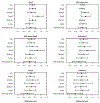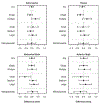Leiomyomata, neonatal anthropometry, and pregnancy outcomes in singleton pregnancies
- PMID: 36822279
- PMCID: PMC10040437
- DOI: 10.1016/j.annepidem.2023.02.008
Leiomyomata, neonatal anthropometry, and pregnancy outcomes in singleton pregnancies
Abstract
Purpose: To investigate the relationship of fibroids in pregnancy, preterm birth, and neonatal anthropometry.
Methods: Pregnant women (n = 2578) in the National Institute of Child Health and Human Development Fetal Growth Studies-Singletons cohort had up to six ultrasounds across pregnancy. Sonographers recorded fibroid number and volume of the three largest fibroids. Trained personnel measured neonatal anthropometry. Linear and logistic regression compared neonatal anthropometry and pregnancy outcomes among pregnancies with versus without fibroids. Causal mediation analysis evaluated preterm birth as a mediator.
Results: Average birthweight did not differ by fibroid status. However, compared with pregnancies without fibroids, neonates from pregnancies with single fibroids had 0.3- (95% confidence interval [CI], 0.0, 0.5) cm larger head circumferences; those with multiple fibroids had 0.3- (95% CI, 0.0, 0.6) cm larger arm circumferences; and those with small fibroid volume had 0.7- (95% CI, 0.3, 1.2) cm larger head, 0.4- (95% CI, 0.0, 0.8) cm larger arm, and 0.7- (95% CI, 0.1, 1.3) cm larger thigh circumferences. Presence versus absence of fibroids was associated with 1.73-2.65 times higher odds of preterm birth. Differences in preterm birth did not explain fibroid-anthropometry results.
Conclusions: We found no evidence that fibroids negatively impacted fetal growth; instead, fibroids were associated with increased head, arm, and thigh circumferences.
Clinical trial registration: ClinicalTrials.gov, NCT00912132.
Keywords: Birthweight; Fibroid; Preterm birth.
Published by Elsevier Inc.
Conflict of interest statement
Declaration of interests
The authors declare that they have no known competing financial interests or personal relationships that could have appeared to influence the work reported in this paper.
Figures




References
-
- Stewart EA, Cookson CL, Gandolfo RA, Schulze-Rath R. Epidemiology of uterine fibroids: a systematic review. BJOG. 2017; 124:1501–12. - PubMed
-
- Pérez-Roncero GR, López-Baena MT, Ornat L, Cuerva MJ, Garcia-Casarrubios P, Chedraui P, et al. Uterine fibroid and preterm birth risk: a systematic review and meta-analysis. Journal of Obestrics and Gynecology Research. 2020; 46:1711–27. - PubMed
-
- Chen Y-H, Lin H-C, Chen S-F, Lin H-C. Increased risk of preterm births among women with uterine leiomyoma: a nationwide population-based study. Human Reproduction. 2009; 24:3049–56. - PubMed
-
- Klatsky PC, Tran ND, Caughey AB, Fujimoto VY. Fibroids and reproductive outcomes: a systematic literature review from conception to delivery. Am J Obstet Gynecol. 2008; 198 357–66. - PubMed
Publication types
MeSH terms
Associated data
Grants and funding
- HHSN275200800014C/HD/NICHD NIH HHS/United States
- Z99 HD999999/ImNIH/Intramural NIH HHS/United States
- HHSN275200800002C/HD/NICHD NIH HHS/United States
- HHSN275200800012C/HD/NICHD NIH HHS/United States
- HHSN275200800003I/HD/NICHD NIH HHS/United States
- K12 HD052163/HD/NICHD NIH HHS/United States
- HHSN275201000001G/HD/NICHD NIH HHS/United States
- HHSN275201000001Z/HD/NICHD NIH HHS/United States
- K12 AR084219/AR/NIAMS NIH HHS/United States
- HHSN275200800003C/HD/NICHD NIH HHS/United States
- HHSN275201000009C/HD/NICHD NIH HHS/United States
- HHSN275200800002I/HD/NICHD NIH HHS/United States
- HHSN275200800028C/HD/NICHD NIH HHS/United States
- ZIA HD008852/ImNIH/Intramural NIH HHS/United States
- HHSN275200800013C/HD/NICHD NIH HHS/United States
LinkOut - more resources
Full Text Sources
Medical

